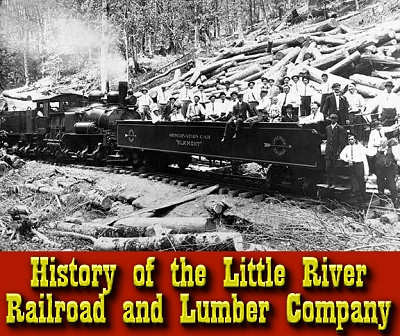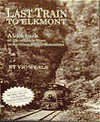 | |||
 |
 |
 | |
 |
 | ||
 |
 | ||
 |  | ||
 |  | ||
 | |||
 |
 |
 | |
 |
 | ||
 |
 | ||
 |  | ||
 |  | ||
| Written by Paul D. Race for Family Garden Trains(tm) |


|
History of the Little River Railroad and Lumber CompanyIn the late nineteenth century, you could start a "railroad company" by getting financing and getting a government bureaucrat to rubber-stamp a permit. Hundreds, if not thousands of railroads existed only on paper. Nearly as many never got from "point A" to "point B" of their original business plan before the initial investments gave out.
On the other hand, construction methods used on most of the railroad resembled narrow gauge industrial practices rather than standard gauge common carrier practice. Some trackage near the logging camps was laid right on the ground, and curves were so tight that the Little River Railroad had to order custom-designed locomotives to pull their trains. Even with such shortcuts, it is estimated that each mile of track through the rugged terrain of the Smokies still cost nearly fifteen times as much as what it cost to build similar railroads elsewhere. Clearcutting - In those days, the "industry standard" for logging companies was to cut down everything useful, and not worry about preserving anything that wasn't. Yes, this approach seems brutal by modern standards, but most of Tennessee, including land adjacent to Townsend's holdings had already been clearcut for other reasons, especially to make room for farms and houses (and eventually strip malls). Unlike those uses of the land, Townsend's purchase actually paved the way for a conservation effort that might never have come about otherwise. Settlements - Several "company towns" were established for the families of the workers. The company not only built "company stores" but also schools and churches. Townsend hired teachers for the one-room frame schoolhouses, and even both Methodist and Baptist ministers for the churches (nearly every family in that part of the country was one or the other). Moving Logs From the Farthest Reaches
Tourism - The Little River Railroad provided access to parts of the Smokies where virtually no one had ever been. In addition, natural springs were considered a source of healing, so several resorts sprang As more and more people saw the Smokies, the more people were convinced that something should be done to preserve them. By the 1920s a movement had started to establish in a national park. The Park Movement Grows - In 1924, prominent local businessmen and others created the Great Smoky Mountains Conservation Association. One obstacle to their success was the fact that there were thousands of separate landowners, and few were interested in selling enough land to make a difference in the Association's efforts. The dream of a national park came closer to reality in 1924 when Governor Austin Peay worked out a compromise - Townsend sold the State of Tennessee and the City of Knoxville options on his land, while retaining the right to log it for fifteen more years. This move guaranteed the park movement nearly 80,000 contiguous acres and proved to conservationists nationwide that the project had a chance. Winding Down - By the late 1930s, most of of the trees had been removed from the Little River Logging Company's acreage. In addition, one of the key industries that the railroad served, Fisher's tannery, burnt down in 1931 and was not rebuilt. The logging camps and company towns were becoming more like ghost towns, although several of the resorts were still doing good business. By 1939, the infrastructure of the logging company was already being dismantled. A few logs were saved to be processed in a "closing ceremony," then the mill was shut down. Although some of the resorts were still in business, reduced tourism during World War II closed several of them soon after. Dismantling the Railroad - Once control of the land was turned over to park managment, the remaining railroad infrastructure was dismantled along with the industries and towns it had served. Ironically, this happened at a time when historical railroads in the West were being featured in movies, preserved as tourist lines, and attracting floods of visitors. In Tennessee, the railroad was apparently too closely associated in people's minds with the logging industry it had been built to serve. So it seemed that the spunky little railroad that first brought national attention and large-scale tourism to the Smokies could not be eradicated soon enough. These efforts have made it difficult for the Little River Railroad and Lumber Company museum to collect artifacts, because so much was destroyed out of hand. Fortunately, the museum has been able to collect many photographs from private owners. In case you wondered, the clearcut regions of the Smokies have recovered their natural appearance, although the tulip and hemlock trees that now cover that land are not the same kinds of trees that were logged out. Overall, the greater design of the conservation efforts is coming to fruition. Still, I can't help wishing I could park my car at Pigeon Forge and take a train almost anywhere I wanted to go in the Smokies, like I could have a century ago. Especially with gas prices and traffic through Gatlinburg being what they are today. Return to the Little River Railroad index page. Links for More Little River Railroad Information
The Museum's Home page: |


|

| 
|
 |
 |
 |
 |
 |
|
Note: Family Garden TrainsTM, Garden Train StoreTM, Big Christmas TrainsTM, BIG Indoor TrainsTM, and BIG Train StoreTM are trademarks of Breakthrough CommunicationsTM (www.btcomm.com). All information, data, text, and illustrations on this web site are Copyright (c) 1999, 2000, 2001, 2002, 2003, 2004, 2005, 2006, 2007, 2008, 2009, 2010, 2011, 2012, 2013, 2014, 2015, 2016, 2017, 2018, 2019, 2020, 2021, 2011, 2023 by Paul D. Race. Reuse or republication without prior written permission is specifically
forbidden.
For more information, please contact us |
 |  |